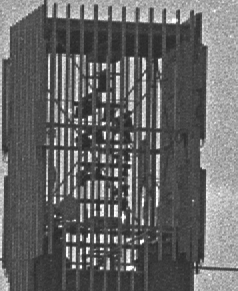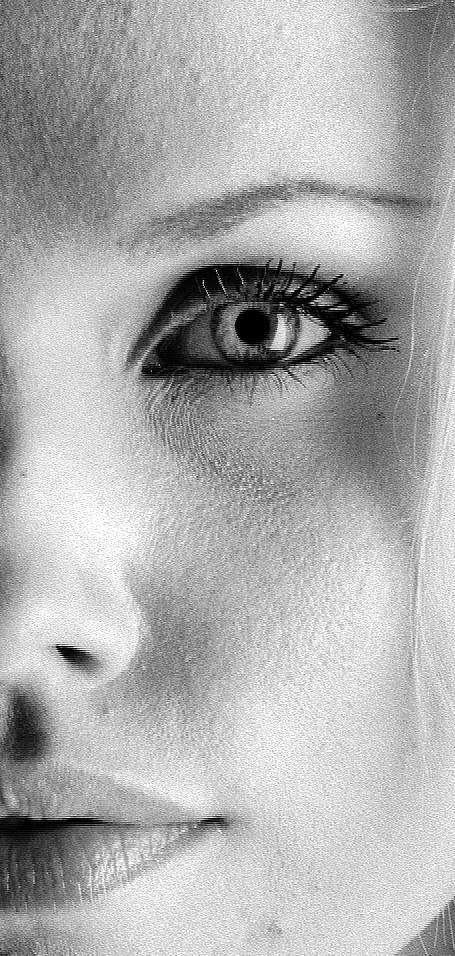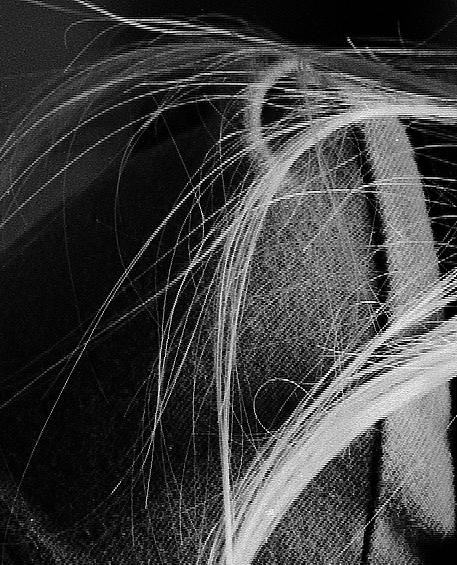Spur DSX32/64 film/developer combination (April 4, 2009)
Introduction
AgX capture technology is limited by the basic chemical properties of the medium. Photographers who put film in their camera know this as the speed-definition-grain triangle. There is a definite relationship between the three dimensions of the triangle: pull at one corner and the others will respond negatively: increase speed and grain increases and definition becomes less: if you want more definition, you loose speed. Definition is here defined as the combined effect of acutance and resolution.
Kodak and Ilford redefined the shape of the triangle with the introduction of T-grain and Delta crystals, but there is no fundamental change involved. Just before the AgX market collapsed, Kodak and Agfa had plans for major jump in quantum efficiency, but shelved this technology as the silicon guys increasingly claimed the stage.
Black and white film is still in wide use and Kodak claims that the classical Tri-X film is their bestselling film. This choice reflects the photographer's preference for the high sharpness, and grainy three-dimensionality of this film of choice for generations of documentary photographers. The recently improved T-Max 400 represents the other side of the coin: fine grain and finely differentiated tonal values.
Many AgX photographers are not looking for speed but for high definition and a long tonal scale. This type of photography exploits the mechanical and optical properties of the camera system to maximize results beyond what is possible with the current crop of high end 35mm-type digital image systems.
Medium speed films like the T-Max 100, 100Delta or FP4 and Plus-X are excellent choices for general purpose high definition photography, but their maximal resolution is limited to about 80 lp/mm.
I have a global network of film users/testers who report on their results and often the results that are reported are higher than what I publish. When comparing test procedures and evaluation criteria there is not that much difference. The decisive factor is the visual evaluation of the resolved lines of the testchart. Some testers prefer the subjective criterium (just resolved difference) to imply that a small difference in density between a black and white line (in fact both are a shade of grey) is enough. In this case the maximum resolution is very high. In print this difference will be completely lost, and you must differentiate between negative resolution and print resolution. I use a more conservative rule: both lines (black and white) must show a clear difference or in other words between two black lines the separation (the white line) must be clearly visible. The numbers that results are less spectacular, but in practical use more useful. As example: T-Max 100 with my approach resolves 75 lp/mm, but when I use the more relaxed criterium I might go to 90 or even 100 lp/mm.
When a true and useful resolution above 100 lp/mm is a requirement, then the choice for a microfilm type of emulsion (often called monodispersion) is mandatory.
The classical emulsion is the Kodak Technical Pan, with which a medium format quality could be reached on 35mm film. This approach was very good as the better optical quality of the top 35mm lenses surpassed the imagery of the equivalent medium format lenses, Zeiss/Hasselblad included.
This emulsion is no longer produced and the Rollei ATP V1 is the claimed successor. While very good, this emulsion has been reported by various sources to occasional clogging in even toned areas like sky.
The second route to high definition film is the use of true microfilm emulsions, Agfa Copex HDP 13, Agfa Copex AHU Rapid and Kodak HQ (image link). Independent research by a consortium of Swiss archival institutes has established that Copex AHU is best for grey tone reproduction with a slight reduction in maximum resolution, while the Copex HDP en Kodak HQ have a steeper gradation curve and are not so good for pictorial reproduction, but show better sharpness.
These microfilms, developed to the standard D=1.0 for reproduction purposes have a good speed, but a very limited tonal range. As soon as you try to expand the tonal range, the speed drops dramatically and the characteristic curve is flattened significantly.
The Copex AHU Rapid emulsion is the base for the Gigabit film, in itself a wise choice, but the claims made by the Gigabit owner gave the film a bad reputation. The claims of high speed (ISO 40), extreme high resolution (above 400 lp/mm) and a very high contrast range (more than 10 stops) could not be substantiated and are in fact empirically out of scope. There are still people who believe these claims, making it hard for other companies to ask attention for their products with lower, but more realistic claims.
The Adox CMS20 (identical with the Spur Orthopan UR) developed in Nanospeed produced a very useful EI of 16 to 20, but this speed is a bit low for general purpose photography, especially if you wish to take the reportage route. The new high speed wide angle Leica lenses (SX21 and SX24) are excellent choices for this type of photography.
The Adox and Orthopan are also a bit steep in their CI and one may assume that these films are identical to the Copex HDP, if you can believe the Swiss study.

The Zone system
I am not a strict follower of the Zone System as the holy grail for fine art photography. The system however is at its best when used as a yardstick for the assessment and reproduction of a range of tonal values from scene to print. The basic idea behind the ZS is the observation that a print paper has a limited capacity for the reproduction of tonal values. The lightest possible tone is the paper white base and the darkest possible tone is the deepest chemical black. Translated into density values this means a range from D=0.05 to D=2.40. This is a brightness range of 1:48. Many books report a brightness range of 1:100 for printing paper However bright or dark the tonal elements of the scene may be (and it can range from 1: 10,000 to 1: 10,000,000 and even more), the total brightness span must be squeezed into the limited range that the paper can accommodate.
There is some confusion why the large differences in scene brightness can be seen with the human eye, assuming that the eye can handle a contrast range from 1: 10,000,000. The fact is that the eye cannot cover such a wide difference at one instant in time but the eye looks at small parts of the scene and the eye has a very fast response time. So when you look at a very dark part and see details and then switch to a very bright part and see details, the brain assumes that the total brightness difference is captured. In fact you are fooled by the fast accommodation response.
The narrow brightness range that the paper can handle is also a characteristic of digital printing paper and the computer screen. The digital camera may employ HDR techniques and can record a difference of more than ten stops in one scene. Ultimately we want a print and then the brightness range must be compressed to fit into the paper range.
The ZS has divided (a bit arbitrary) the total brightness range of the printing paper in ten zones, every zone differs by one stop from the adjacent one. Zone 5 is the average grey value and the density of every zone is such that details are visible in the zones 3 to 7 ( five stops brightness difference) and the zones 0 to 2 and 8 to 10 add atmosphere to the print.
The ZS approach focuses on a 1:1 correspondence between the tonal values of the scene and the print, the negative just being an intermediate layer. The negative densities are selected such that with the available printing papers this correspondence is possible. When you graph the normal density values of the negative, you will see that the ' curve' is a straight line. The match with the curve of the printing paper results in the final curve having the classical S-shape. Let us take a scene with a brightness range of six stops. This scene will fit nicely into the 5 to 6 zones with detail of the negative and print. Very small brightness differences will be revealed. Now we have a scene with 14 stops of brightness difference. This range must also be fitted into the zonal range of 5 to 6 stops. It is clear that fine tonal differences will be compressed in such a way that they fall below the threshold of just visible differences. The total contrast in the print is the same as with the previous scene (maximum white and maximum black do not differ in the print), but the mid range of tonal values is compressed. In addition to the formal ZS values and approach, there is also a light version of the ZS, called the snapshot method: here the contrast index is higher, the EI is higher and the shape of the curve is more appropriate for street photography.
In the graphs I have drawn in both curves as a reference to the film emulsions tested. This long introduction is necessary to provide a context for the test of the new Spur DSX32/64 film/developer combination.
Below you see a simple scene with the sun shining directly into the camera lens. The DSX has been able to capture the full brightness range with excellent tonal values. Note the fine tonal differences in the sky. In reality this part was totally washed out.


Below is a detail from this scene (the tower in the middle of the scene). It depicts excellent sharpness and very fine detail. This is a handheld shot!

Test conditions
The camera used is the Leica M7 with various lenses, depending on the test subject. The resolution tests were done with the Elmarit-M 2.8/24mm ASPH, the normal scenes with the Summilux-M 1.4/50mm ASPH and the Elmar-M 3.8/24mm ASPH. The film was exposed at various EI values from ISO40 to ISO64. Exposure was done with a handheld Gossen Mastersix, calibrated at the factory to 0.1 of a stop. Development with Heiland TAS film processor for six minutes.
Test results.
The maximum resolution was fixed at 125 to 140 lp/mm, according to my subjective analysis. A nominal value of 150 to 160 lp/mm may be accepted. This is an extremely high value and much higher than can be recorded with digital cameras. It is evident that this value is a bit theoretical, as there are not many scenes where you can find this level of definition and you need large prints to show this. My scanner (Coolscan LS5000) at 4000 dpi did fail to capture this amount of detail. Compare this value with the resolution that the T-Max 100 can hold (70 to 80 lp/mm) and you can appreciate the quality of the DSX film.
For now I would state that this film has the highest useable resolution of all films I have tested.
This level of definition is only worth the trouble if it is accompanied with a good tonal range that delivers very fine tonal hues. I exposed the film with a range of 14 stops. The range from 0 to 10 is seen in the accompanying graph. The amazing point is the close conformance with the official ZS values. This curve is for EI = ISO50. The claimed ISO64 is well within the tolerance range and in the shadows a bit better even than Tmax. The densities for the zones 11 to 14 are from 1.68 to 1.83. These values are within the snapshot range and would fit into the maximum values of the Zone System values with N+1 development. For a microfilm with an inherently very steep gradation, this result is excellent.
Modern black and white films are a bit thin in the shadow range, but that is possible because of the properties of variable contrast paper.
The grain is extremely fine and will not be visible in prints at sizes to 50 x 60cm.
Conclusion
T
he new Spur DSX 32/64 film/developer combination is the best implementation of microfilm technology for pictorial photography I am aware of. The film is especially valuable for high definition spontaneous photography with good equipment. Street and documentary photographers can add a special dimension to their prints with extended detail normally not visible in snapshot photography. Studio and location photography on tripod will get excellent definition of a very high order accompanied by a tonal range of zone system properties. The film has a limited latitude for expansion and compaction and should be used with the narrow range of ISO 40 to ISO64.
Below a picture of a model.
Two details can be seen below: part of the face and a part of the cloth. Note the fine differentiation of the textural detail in the shoulder par at the left of the picture.








